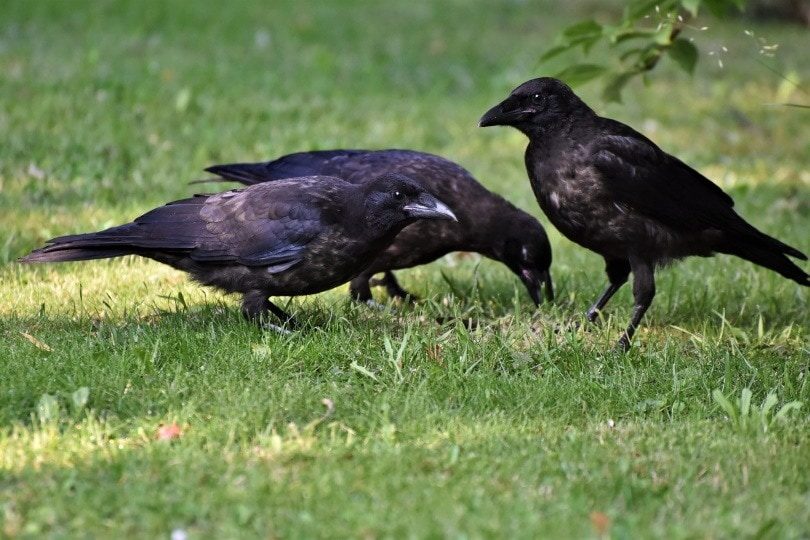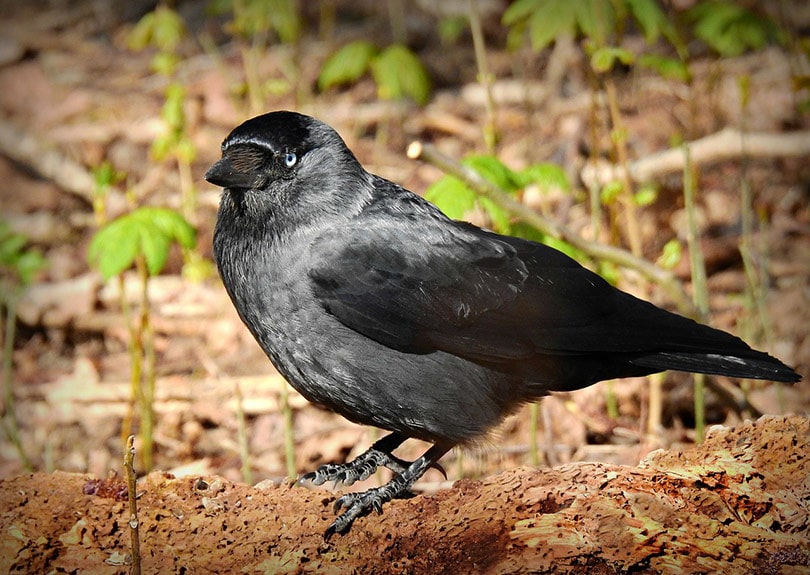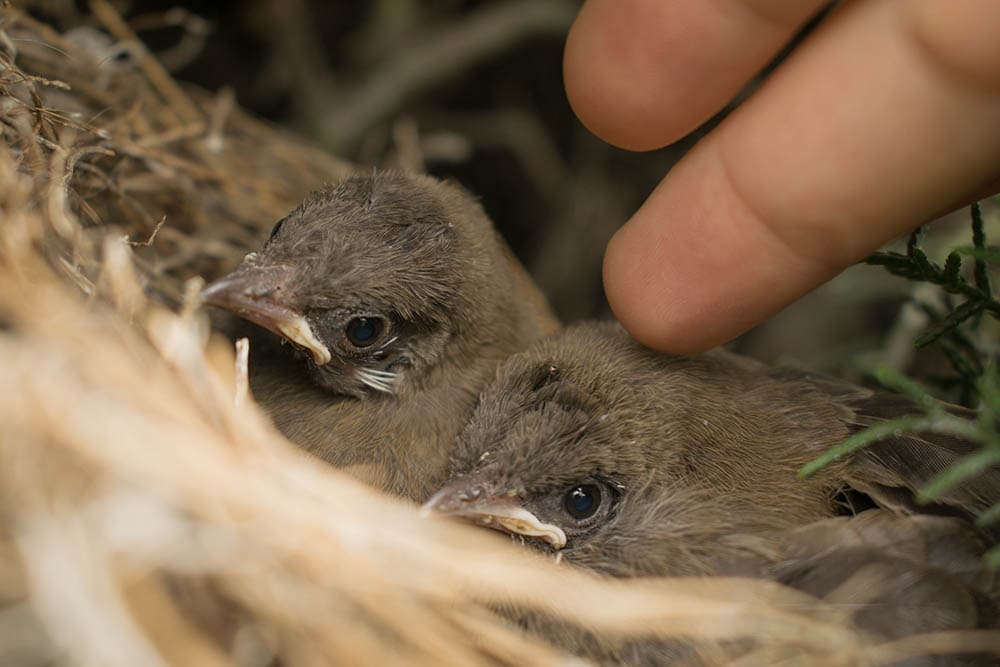6 Types of Black Birds in the UK (With Pictures)
Last Updated on

There are nearly 10,000 species of birds, ranging from an ostrich to the hummingbird, which is so tiny that it weighs less than an acorn. The British List, maintained by the British Ornithologists’ Union (BOU), recorded 628 species of wild birds in Great Britain.
From a distance, some birds can look alike. The starling, for example, is smaller than a blackbird and can appear completely black from a distance. It isn’t until you’re closer that you realize they’re glossy, with a sheen of green and purple. Out of all these birds, which ones are entirely black, and where can you find them?

The 6 Types of Black Birds in the UK:
1. Carrion Crow

| Wingspan | 73-90 centimeters |
| Length | 45-47 centimeters |
| Weight | 260-350 grams |
| What They Eat | Carrion, insects, worms, seeds, fruit, eggs, and scraps |
The carrion crow is adaptable and one of the cleverest birds on our list. They’re cautious, and you’ll notice when they venture into your garden for food. If they grow to trust the environment, they’ll repeatedly return to take advantage of anything they can find.
The carrion is fearless but tends to be wary of men. They occasionally form flocks but mostly stay in pairs or alone because they are relatively solitary. You can find them almost anywhere in the UK.
The hooded crow, which is closely related to the carrion, has recently been split into a separate species. Since it isn’t completely black, it doesn’t appear on our list.
2. Chough

| Wingspan | 93-104 centimeters |
| Length | 39-40 centimeters |
| Weight | 370-650 grams |
| What They Eat | Insects and larvae |
The chough (pronounced “chuff”) is also a member of the crow family. Unlike other crows, however, it has a red bill and legs. You’d think that would make it easier to spot, but there are only small coastal populations in the Isle of Man, Scotland, Ireland, and Wales.
Its natural habitats are coastal regions, heathlands, and moorlands. The chough is the symbol of Cornwall, and while it has been extinct as a breeding bird in Cornwall for quite some time, a tiny population has returned to the far west of Cornwall to nest.
3. Jackdaw

| Wingspan | 70 centimeters |
| Length | 34 centimeters |
| Weight | 220 grams |
| What They Eat | Insects, young birds and eggs, fruit, seeds, and scraps |
The Jackdaw is the smallest crow and has distinctive pale eyes and a silvery sheen on the back of its head. It’s believed the Jackdaw gets its name from the two different words “jack,” meaning rogue, and “daw,” which is an imitation of its call. Jackdaws are talented thieves that steal other birds’ eggs and break into garden feeders.
They are generally found in woods, parks, fields, and gardens. They’re social birds and are widespread across the UK, except in the Scottish Highlands.
4. Raven

| Wingspan | 120-150 centimeters |
| Length | 60-68 centimeters |
| Weight | 800-1,500 grams |
| What They Eat | Carrion, mammals, birds and eggs, insects and other invertebrates |
The raven is a huge crow, even bigger than a buzzard, and is the largest member of the crow family. They usually nest on cliffs around the coast, in large trees, quarries, and mountains. Ravens can be found in upland areas of southwest England, Wales, the Lake District, the North Pennines, and most of Scotland.
Two interesting facts about ravens are that they pair for life and are part of a legend: if the tame ravens that guard the Tower of London leave, the City of London will fall.
5. Rook

| Wingspan | 81-99 centimeters |
| Length | 44-46 centimeters |
| Weight | 280-340 grams |
| What They Eat | worms, grain, nuts and insects, small mammals, birds (especially eggs and nestlings), and carrion |
Rooks are large crows that often nest in villages and graveyards but have also been known to reside in grasslands and farmlands. They are sociable birds, and a large colony of rooks is known as “rookeries.” Interestingly, a group of rooks is known as a parliament.
Rooks live throughout the UK but are absent in the far north-west of Scotland.
6. Blackbirds (Male)

| Wingspan | 34-38.5 centimeters |
| Length | 24-25 centimeters |
| Weight | 80-100 grams |
| What They Eat | Insects and worms, and berries and fruits when they’re in season |
Blackbirds are part of the thrush family, and only the males are entirely black. The females are brown, usually with spots and streaks on their breasts. In the UK, the blackbird is one of the most common birds, and if you spend a lot of time in your garden, you’ve probably heard them singing. They live in the countryside and around parks, but not on the highest peaks. Blackbirds are migratory; Scottish populations will visit Northern Ireland.
FAQ
What Do I Do if I Find an Injured Bird?
Being handled and treated is a stressful experience for a bird; capturing them can cause further injury. You should only help if it’s unlikely the bird will survive on its own. Firmly but gently position your hand so the bird’s head is between your thumb and forefinger, and your fingers will naturally wrap around the wings. Medium-sized birds will require two hands, one over each wing, and larger birds may need an expert because they could cause you injury.
Once you’ve caught the bird, examine it and place it in a well-ventilated box. Darkness will reduce their stress, and it’s also the best treatment for shock.

Who Do You Contact?
You can contact the RSPCA in England and Wales, SSPCA in Scotland, or USPCA in Northern Ireland for advice. An injured bird can be taken to a local vet or an independent rescue center. If a cat injured the bird, take them to a vet as soon as possible because the fatal risk of septicemia is high.
Remember, a vet is always your best option. The RSPCA, SSPCA, and USPCA are wildlife conservation charities, and they can provide advice on injured wildlife, but they don’t have the facilities to treat injured birds.
What if There’s a Baby Bird on the Ground?
You can gently put it back in its nest if it has no feathers. If you can’t see a nest or cannot reach it, you can contact an animal welfare organization like the RSPCA for advice.
It’s not true that a baby bird’s parents will abandon it for being touched by a human. However, don’t handle baby birds unnecessarily. If the baby bird has feathers, it’s called a fledgling. It’s perfectly normal for a fledgling to spend a few days on the ground, and they can be left alone unless they are in immediate danger. Move them to a sheltered spot to keep them safe.


Conclusion
It’s easy to mistake one bird for another, especially if you’re too busy reading your book and soaking up the sun. We hope you take a moment to look up from what you’re reading to look at the birds around you because, while they can seem similar, they’re all unique and fascinating.
Most of the birds on our list are part of the crow family (also known as corvids). Crows are known for their intelligence and can recognize human faces, use tools, and have shown the ability to problem solve. If you want to attract a blackbird into your garden, leave out some old apples or plant berry-producing bushes.
Featured Image Credit: Capri23auto_Pixabay
About the Author Kerry-Ann Kerr
Related Articles:
Monocular vs Telescope: Differences Explained (With Pictures)
10 Types of Hummingbirds in Arkansas (With Pictures)
8 Types of Hummingbirds in Nebraska (With Pictures)
5 Types of Hummingbirds in Idaho (With Pictures)
3 Types of Hummingbirds in Mississippi (With Pictures)
8 Types of Hummingbirds in Kansas (With Pictures)
5 Types of Hummingbirds in West Virginia (With Pictures)
5 Types of Hummingbirds in Ohio (With Pictures)
